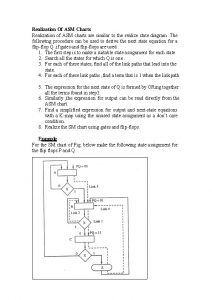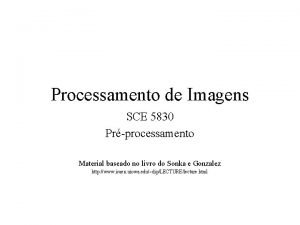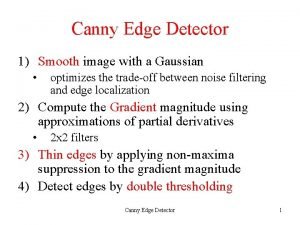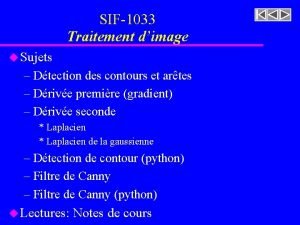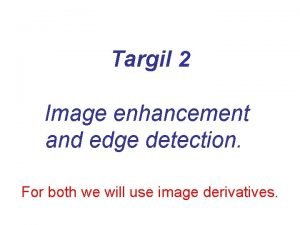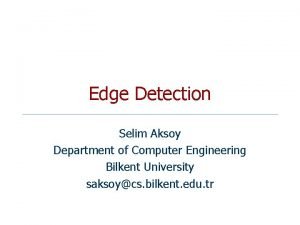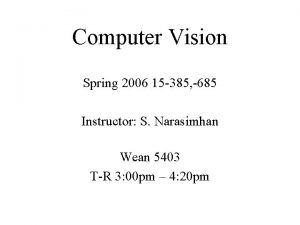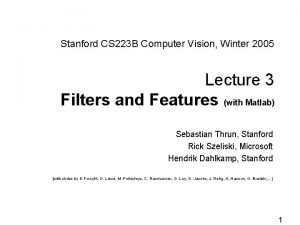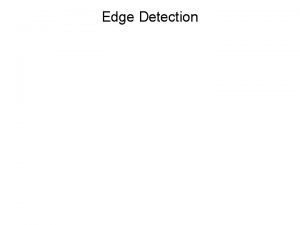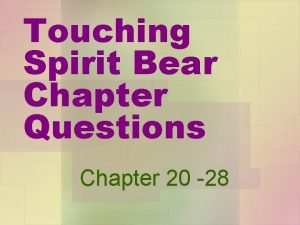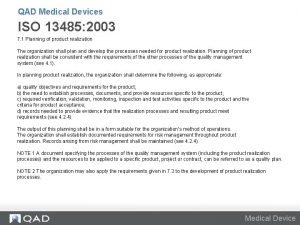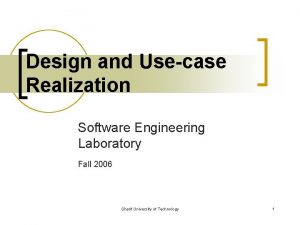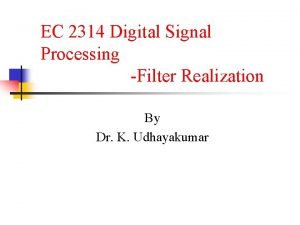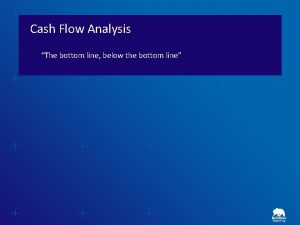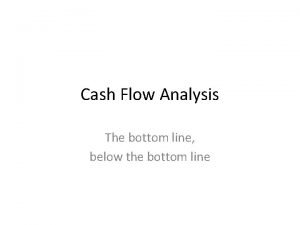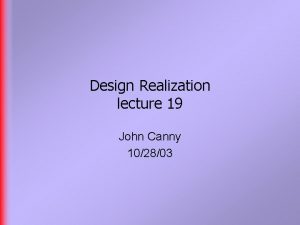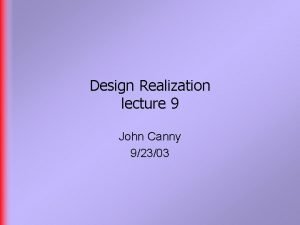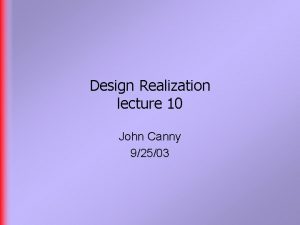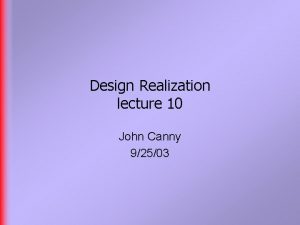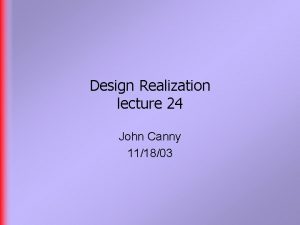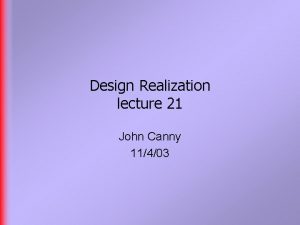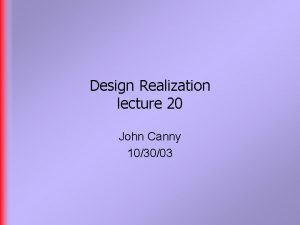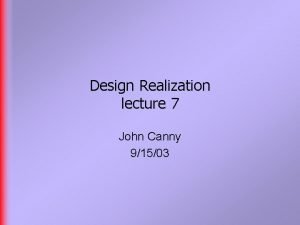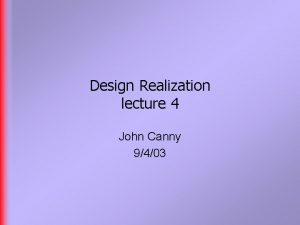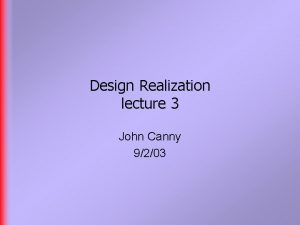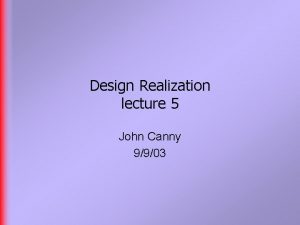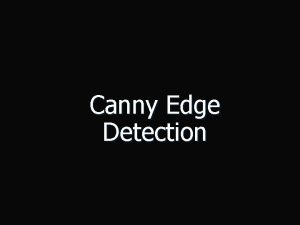Design Realization lecture 18 John Canny 102303 Last






























- Slides: 30

Design Realization lecture 18 John Canny 10/23/03

Last time § Processors and networks § Printed-circuit board design

This time § Sensors

Sensors § We’ll discuss sensors for: § § § § § Light Heat Sound Distance Touch/pressure Displacement/angle Location/heading Movement Acceleration Chemicals/scents

Light energy § For a sensor, we’re interested in the light power that falls on a unit area, and how well the sensor converts that into a signal. § A common unit is the lux which measures apparent brightness (power multiplied by the human eye’s sensitivity). § 1 lux of yellow light is about 0. 0015 W/m 2. § 1 lux of green light (50% eff. ) is 0. 0029 W/m 2. § Sunlight corresponds to about 50, 000 lux § Artificial light typically 500 -1000 lux

Light sensors § Simplest light sensor is an LDR (Light. Dependent Resistor). § Optical characteristics close to human eye. § Can be used to feed an A/D directly without amplification (one resistor in a voltage divider). § Common material is Cd. S (Cadmium Sulphide) § Sensitivity: dark 1 M , 10 lux 40 k , 1000 lux 400 .

Light sensors § Semiconductor light sensors include: photodiodes, phototransistors, photodarlingtons. § All of these have similar noise performance, but phototransistors and darlingtons have better sensitivity (more current for given light input). § Phototransistor: 1 m. A @ 1000 lux § Photodarlingtons up to 100 x this sensitivity.

Light sensors – high end § At the cutting edge of light sensor sensitivity are Avalanche photodiodes. § Large voltages applied to these diodes accelerate electrons to “collide” with the semiconductor lattice, creating more charges. § These devices have quantum efficiencies around 90% and extremely low noise. § They are now made with large collection areas and known as LAAPDs (Large. Area Avalanche Photo-Diode)

Light sensors – cameras § Two solid-state camera types: CCD and CMOS. § CCD is the more mature technology, and has the widest performance range. § 8 Mpixel size for cameras § Low noise/ high efficiency for astronomy etc. § Good sensitivity (low as 0. 0003 lux, starlight) § CCDs require several chips, but are still cheap ($50 +) § Most CCDs work in near infrared and can be used for night vision if an IR light source is used.

Light sensors – cameras § CMOS cameras are very compact and inexpensive, but haven’t matched CCDs in most performance dimensions. § Start from $20(!) § Custom CMOS cameras integrate image processing right on the camera. § Allow special functions like motion detection, recognition.

Temperature/Heat sensors § Many devices can measure temperature. Basic heat sensors are called “thermistors” (heatsensitive resistors). § Available in a very wide range of resistances, with positive or negative resistance change/temp. § 1 -wire device family includes a thermometer.

Heat vision § Heat can be “seen” at a distance. Recall temperature = heat/atom. At room temp each atom has average energy 6. 3 x 10 -21 J (lecture 10). § Some of this energy is emitted as photons. § A photon of energy E and frequency f satisfies: E=hf where h is Planck’s constant = 6. 63 x 10 -34 J sec § Thermal photons have frequency ~ 1013 Hz and wavelength ~ 30 m § This is in the far infrared range. Sensors that respond to those wavelengths can “see” warm objects without other illumination.

Thermal imagers § Far infrared CCD cameras exist for 10 m and above, but are much more sophisticated (and expensive) than near-infrared CCDs. § Generally many $1000 s

Thermal sensors § PIR (Pyroelectric Infra. Red) sensors can detect IR heat radiation (7 -20 m typical). § They are simple, cheap and common. The basis of security system “motion detectors”. § Most PIR sensors contain two or four sensors with different viewing regions. § They detect a change in the difference between the signals and give a binary output.

Thermal sensors § A few component PIR sensors are available that provide the PIR analog signals directly. § Eltec two-element sensor, shown with matching fresnel IR lens and mounting: § NAIS ultra-compact PIR sensor § Note: PIR sensors are slow with time constants ~ 1 sec

Sound sensing § Microphone types: § Dynamic (magnetic), high-quality, size, cost § Piezoelectric, small, cheap, fair quality § Condenser, good quality, cheap, small § Condenser mikes are the most common, and range from low-end to top-end in performance.

Sound sensing § Most condenser mikes include a built-in amplifier, and must be connected to a voltage supply through a resistor. § Almost any microphone will need further amplification before being fed to an A/D. Many audio preamp ICs can be used for this.

Distance sensors § Many kinds. At the low end, IR range sensors (Sharp sensor example). § An LED transmits (modulated) light, a phototransistor detects the strength of the modulated return signal. Good to a few ft.

Distance sensors § Sonar sensors. Polaroid sells several sonar modules that are very popular in mobile robot applications. Several pulses per second. § Can measure range up to 30’ or more.

Distance sensors § Phase delay light sensors. Light beam is modulated with radio frequency signal. § Phase shift of return beam gives distance. § Can give very high accuracy (mm or better). § Used in high-end laser systems ($100 s$1000 s). § Simple versions were available for ~ $100 several years ago. Can be custom-built for this price.

Touch sensors § We have several overlay touch screens (< $100) for laptop screens. § Tactex makes high-performance touch surfaces: § They respond to multiple finger contacts, 8000 samples/sec. § Intended for digital music input, and other expressive interactions.

Touch sensors § Piezoelectric film creates voltages in response to strain. It can be cut to custom shapes for special-purpose sensors. § Sensors include accelerometers, bend sensors, hydrophones, … § MSI (Measurement Specialists Inc. ) sells a variety of piezo film products.

Displacement/Angle Sensors § A very simple way to measure displacement or angle is to use a potentiometer as a voltage divider with output to an A/D converter. § Precision potentiometers come in both linear and multi-rotation angular types.

Displacement/Angle Sensors § Encoders measure relative displacement. § A pattern of light-dark bars is attached to the moving element. § Light sensors observe each region. § The number of transitions encodes the movement in either direction. A B

Location/Direction § § GPS provides location in LAT/LONG coords. Standard NAVSTAR systems good to ~ 5 m. Survey grade GPS accurate to a few inches. Location calibration points may push consumer accuracy toward the latter figure. § Bluetooth GPS modules now ~ $200. § Cost increment for GPS in CDMA cell phones ~ $5

Location/Direction § Small magnetic compasses are available, such as the trekker ($65 kit): § Can be tricky to use magnetic compass data indoors, but we had good luck with it in nonmetallic robots.

Location/Direction § Gyroscopes maintain direction information with fast response time. § Small gyros were developed for model helicopter use (~ $200). 270 Hz update.

Movement § For motion tracking indoors, magnetic field systems are popular. § Ascension Technologies “Flock of Birds” systems are very popular. § Wired units are moved and all 6 degrees of position and rotation freedom are tracked.

Acceleration § Accelerometers are based either on MEMs or piezo-electric components. § Analog devices ADXL-series is a good example: ADXL 202 § 2 -axis § 2 mg resolution, 60 Hz § 6 k. Hz sensing range § ~ $20 and dropping.

Scent-sing
 Asm chart
Asm chart Qual tipo de filtro é o de canny?
Qual tipo de filtro é o de canny? What is canny edge detection in image processing
What is canny edge detection in image processing Filtre de canny python
Filtre de canny python Targil
Targil Joe canny
Joe canny Canny
Canny Canny
Canny Canny sebastian
Canny sebastian Canny mask
Canny mask 01:640:244 lecture notes - lecture 15: plat, idah, farad
01:640:244 lecture notes - lecture 15: plat, idah, farad Randy pausch the last lecture summary
Randy pausch the last lecture summary What realization does cole have regarding his father
What realization does cole have regarding his father Sanaubar kite runner
Sanaubar kite runner Iso 13485 product realization
Iso 13485 product realization What is use case realization
What is use case realization Self realization aristotle
Self realization aristotle What is use case realization
What is use case realization What is use case realization
What is use case realization Realisation structures in signal processing is for
Realisation structures in signal processing is for Cash realization ratio
Cash realization ratio Calculate time interest earned
Calculate time interest earned Cognitive provides various channels for self-realization.
Cognitive provides various channels for self-realization. Corbiran
Corbiran Practical design to eurocode 2
Practical design to eurocode 2 Urban design lecture
Urban design lecture Elements and principles of interior design ppt
Elements and principles of interior design ppt Lecture hall acoustics
Lecture hall acoustics Game design lecture
Game design lecture Computer-aided drug design lecture notes
Computer-aided drug design lecture notes Cmos vlsi design lecture notes
Cmos vlsi design lecture notes
